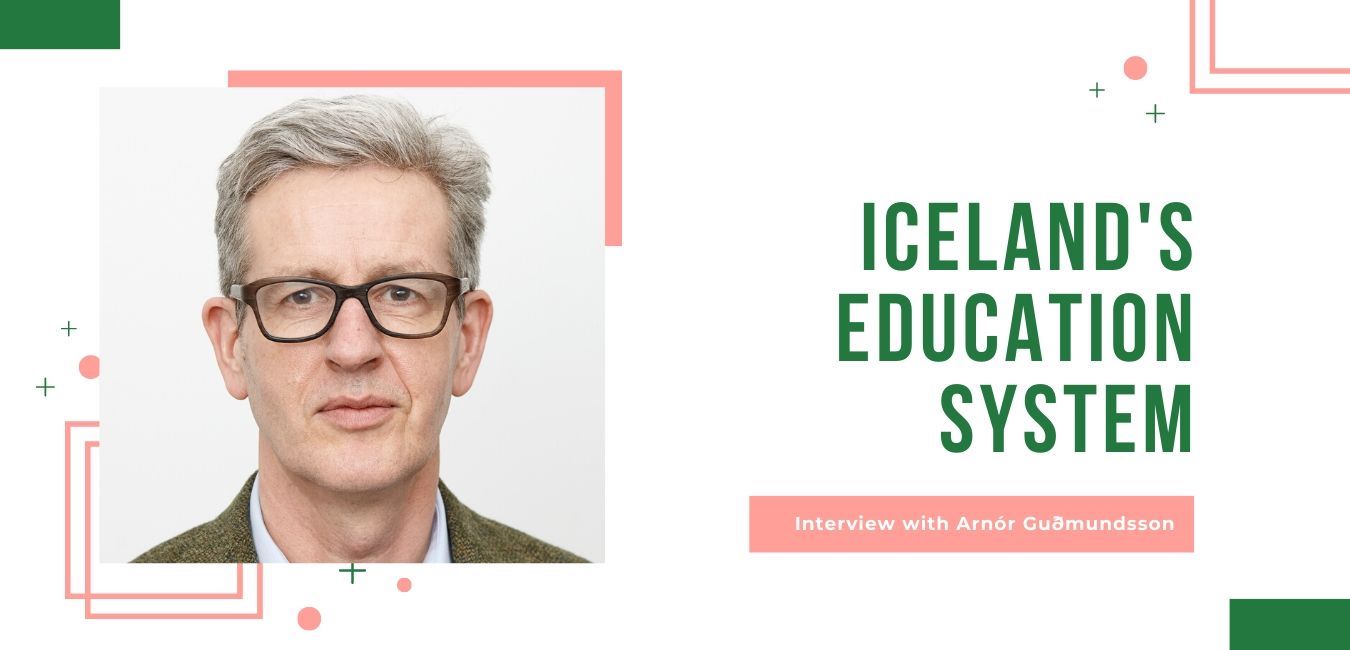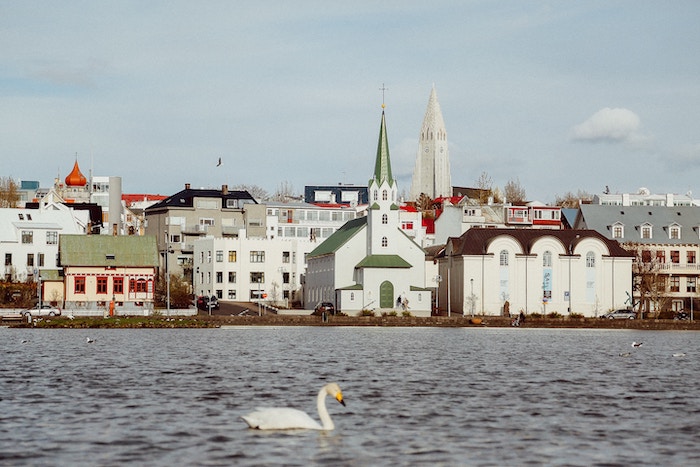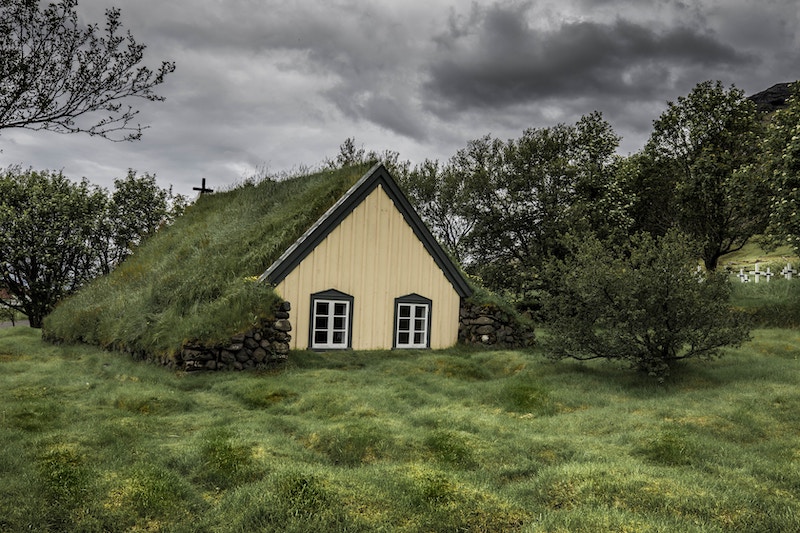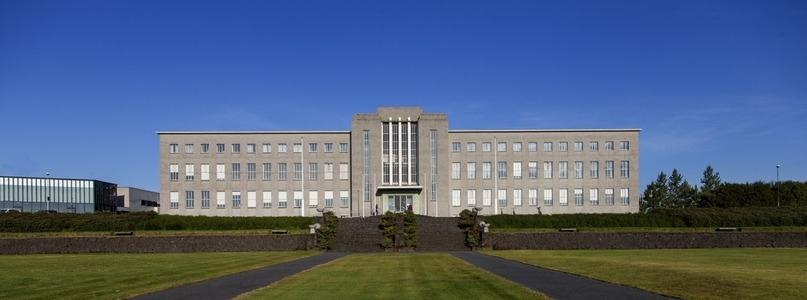

To get a better understanding of the Icelandic education system, I sat down with Arnór Guðmundsson for this episode of the All Things Iceland podcast. In his role as the Director of the Directorate of Education, his agency focuses on testing and producing textbooks for schools in Iceland. We discussed many things. Some of them include the different levels of education in Iceland, how the Icelandic education system compares with other countries, and some challenges the Directorate is facing.
The continued decrease in literacy among Icelandic teenage boys and how the survival of the Icelandic language is threatened by English are topics most people are not aware of who live outside of the country. Arnór was helpful in giving an overview of the system. I have also included answers to frequently asked questions regarding the Icelandic education system, which are not in the podcast interview.

Contents
Questions I asked Arnór during the interview:
- What made you interested in working in the Directorate of Education in Iceland?
- How is the education system in Iceland setup? What are the different levels?
- I assume that technology is used quite a bit in schools here. I am just wondering how it is used in the different education levels. Is it used early on or does the introduction of technology start at a later education level?
- Is it important to promote and foster creativity in schools in Iceland?
- What is the difference in the standard of education between public schools vs private schools in Iceland?
- How does the education system in Iceland compare with other Nordic countries?
- When a child that doesn’t speak or understand Icelandic enters the education system, is there a process for helping them to learn the language?
- What are some challenges regarding the education system that the Directorate of Education is trying to tackle?
- I read a recent article about the reading comprehension being much poorer in Iceland than in other countries. Basically, the amount of students that did not achieve basic reading comprehension standards increased quite a bit. What do you think are some of the reasons why reading comprehensions skills among some students has deteriorated?
- Is there any concern about how much English is being used among teenagers in Iceland?
- You studied at the University of Minnesota back in the 90’s. Do you feel that your education in Iceland back then had prepared you for studying in the U.S.?
- Please share your impression of the education system in the United States on a university level
- What is your favorite Icelandic word or phrase?
What is the history of the education system in Iceland?

One of the oldest educational institutions in Iceland, Menntaskólin í Reykjavík, can be traced back to 1056! For centuries, education in Iceland has been of great importance. However, the first national education law wasn’t passed until 1907. Later, the Compulsory Education Act of 1974 modernized the Icelandic education system. It included a mandate for providing special education services to all students with disabilities.
Three former schools, Prestaskólinn, Læknaskólinn and Lagaskólinn, were combined to create the University of Iceland in 1911. The schools individually taught theology, medicine and law. Naturally, the professors in the early days of the university only taught those classes for those specific fields. Over time, the fields and expertise of the faculty have diversified. This university is the country’s oldest and largest institution for higher education.
Governing Agency for Icelandic Education
The Ministry of Education, Science and Culture was established in 1942 and has the jurisdiction of educational responsibility in the country. It issues the national curriculum guidelines for the educational institutions. Most schools in Iceland are public but there are a small number of private schools that have popped up. Interestingly, the Icelandic education system has been decentralized over the years. The local authorities are responsible for the primary and lower schools. While the Ministry is responsible for the upper secondary schools and higher education.
About five years ago, the National Center for Educational Materials and The Education Testing Institute combined to become the Directorate of Education. As mentioned in the podcast interview above, Arnór leads that agency.
What are the levels in the Icelandic education system?
There are four levels of education in Iceland. They are playschool, primary school, upper secondary school, and higher education.
These levels are split into compulsory and non-compulsory. Play school, upper secondary school and higher education are non-compulsory. Primary school is the only compulsory, or mandatory schooling in the country.
Pre-primary school or Play school (Leikskólí)

Parents with children between the ages of two and six can opt to send them to play school. While it is not mandatory for the child to attend this level of schooling, it is helpful for them because specific curriculum has been set up at this level. It is meant to help the child transition to the compulsory education level. Play school is not free but the cost is subsidized by the local municipalities.
About 30% of the fees paid by parents covers the cost of running the playschools. If a parent opts to send their child to a private playschool, they will pay about 10-20% more than the public institutions. The time spent at a play school can vary. The range is normally a minimum of four hours and a maximum of nine hours per day.
Compulsory (Primary) Education
Compulsory education consists of primary and upper secondary school. In Iceland, children between the ages of six and sixteen must attend school. The school year begins between August 21st and September 1st and ends between May 31st and June 10th. Children attend school five days a week and must have a minimum of 180 school days in the year. As in other countries, the parents of children in Iceland are responsible for their children attending school. As mentioned in the history of the Icelandic school system, the municipalities fund the schools and provide the necessary resources. These include teachers, administration, specialists and special education. 100% of students that are supposed to attend school are accepted and this level of education is completely free.
Due to the population in each area around the country, compulsory school sizes can vary widely. It is not uncommon for there to be less than ten students in a rural school in Iceland, but around 1200 students in a school in Reykjavík. Interestingly, around 50% of Icelandic schools have less than 100 students. Regardless, all of the institutions must follow the national curriculum guidelines. Along with the guidelines, schools are required to provide extracurricular activities, assessments for teachers and students, counseling, an annual calendar and a work plan for their school.
Upper Secondary Education (Framhaldsskólí)

Any student that has completed their compulsory Icelandic education has the right to upper secondary education. Within the last few years the length of upper secondary education has changed from four years to three. Students are typically sixteen years of age when they start and nineteen when they graduate. However, this time frame can be different for a student enrolled in vocational courses. All the schools at this level are mixed sex and their are no tuition fees. However, there is an enrollment fee and all students are expected to pay for their own textbooks.
Admittance
If a student doesn’t meet the entry requirements for different courses, they will be given a general study program. Because there are different upper secondary schools in Iceland that provide unique educational experiences, some schools are more popular than others. It is common that an upper secondary school has to turn away hundreds of applicants for the upcoming school year. There are about 40 upper secondary schools in Iceland. Similar to compulsory school, the size of the students in the schools vary based on the population in the area of the country that the school is in. The smallest school might have fifty students, while the largest school can have over 3,000.

The school year is split into fall and spring semesters. Iceland has about 40 upper secondary schools and they are divided into grammar schools, industrial-vocational schools, comprehensive schools, and specialized vocational schools. It is required by law that all of these types of schools are a combination of academic, vocational, artistic, and general programs of study. To be eligible for higher education, a student needs to pass a matriculation examination. It is called a Stúdentpróf in Icelandic and all upper secondary schools in the country can offer it.
One of the fascinating parts about this level of education is that the student is in control, to a degree, of how fast or slow they finish their education. A certain number of course units are available each term. Within those course units are a certain number of course credits. This is more similar to how the system is set up for college students in the United States. Evening classes and distance learning are also offered at many schools. Like compulsory school, counseling services are also offered at this educational level.
Higher Education (Háskólí)

Most of the seven higher education institutions in Iceland are run by the state. Háskóli Íslands or the University of Iceland is the country’s first and oldest university. It was established in 1911, but since then other schools have opened up around the country. There is a mix of private and public universities in Iceland, and they both receive state funding.
Admittance Information
While many students in Iceland attend a higher university at home, there is also a decent amount that choose to study in a different country. The majority of students that want to attend a háskóli must pass an exam. However, work experience can be taken into account for acceptance, when it applies. For students in Iceland, registration for háskóli is from April to June each year. Foreign students must apply by the date specified by each university. Like upper secondary school, the school year for higher education institutions lasts from September to May. They are divided into fall and spring terms.
Financing for Attending a University in Iceland
Thankfully, there are no tuition fees for institutions in Iceland that are run by the state. However, you are required to pay a registration fee. If you opt to attend a private university, you will be charged tuition fees. Every student in Iceland is eligible for financial support from the Icelandic Student Loan Fund. The student’s personal and financial circumstances will determine the amount. People from the European Union or EEA-EFTA countries are also eligible for loans if they meet certain requirements.

Each year the Icelandic Ministry of Education, Science and Culture awards scholarships to students of foreign origin. These are given to people intending to study the Icelandic language, literature or the history at the University of Iceland.
Some of scholarships for higher education in Iceland are the following:
- Fulbright Scholarships
- Icelandic-American Society Scholarships (Thor Thors, Haystack, Luther College)
- American-Scandinavian Foundation Scholarships
- Leifur Eiríksson Foundation Scholarships
For more about grants in Iceland, I suggest checking out the information on the local grants program on U.S. Embassy’s website.
Do you need to know Icelandic to study in Iceland?
Yes and no. The answer to this question depends on if you are studying at the undergraduate or graduate level in Iceland. All undergraduate programs in Icelandic universities are primarily taught in Icelandic. Even though the textbooks and a class or two might be in English, you are expected to fully understand Icelandic if you plan to be an undergraduate student. Many foreigners come to Iceland for graduate level studies (Masters and Ph.D), because a good portion of them are taught in English.
How many universities does Iceland have?
Iceland has seven universities and they are:
- Agricultural University of Iceland
- Bifröst University
- Holar University College
- Iceland Academy of Arts
- Reykjavik University
- University of Akureyri
- University of Iceland
Are there private schools in Iceland?
Yes, there are private schools in Iceland across all levels of study. There are a few international schools, as well.
Is education free in Iceland for international students?
Yes and no. Compulsory (or mandatory school) for children aged six to sixteen is free. Play school has an annual fee. State-run higher education institutes in Iceland do not have tuition fees but there is an annual registration fee.
Let’s be social! Here is where you can connect with me:
I hope you enjoyed listening to this interview. Make sure you are subscribed to the All Things Iceland podcast so you don’t miss new episodes. If the platform you are listening to this podcast on allows you to leave a review, please do so, if you haven’t already.
Þakka þér kærlega fyrir að hlusta (og að lesa) og sjáumst fljótlega
Thank you kindly for listening (and reading) and see you soon!
